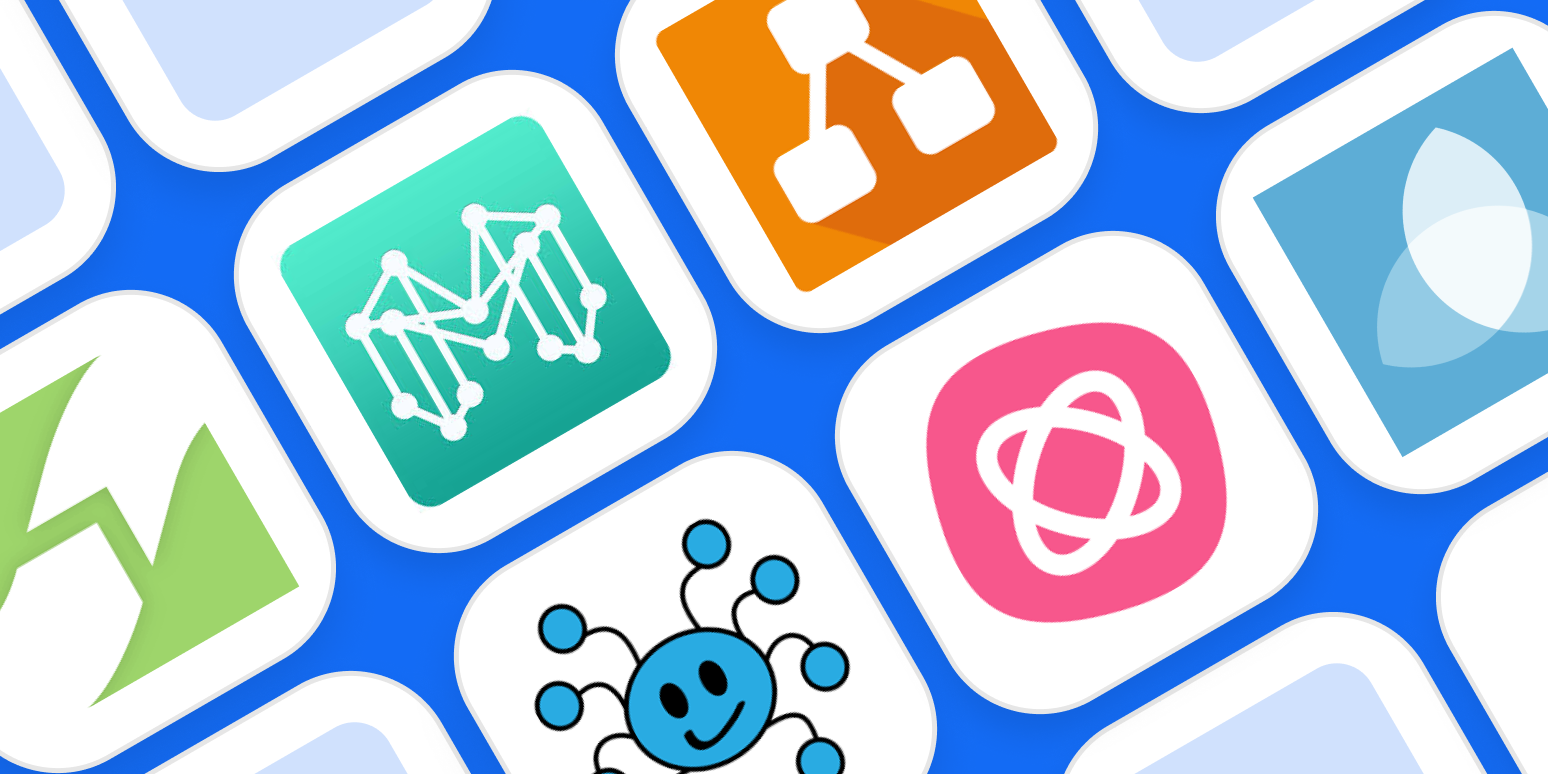Mind mapping is a powerful creative exercise for brainstorming ideas and finding connections. You start by writing down a central idea or theme, then draw lines branching out into new “nodes,” each with their own related idea or theme. You keep going, diving deeper until you’re out of ideas—and the relationships between things appear.
Mind mapping is traditionally done with a blank piece of paper, but there’s a lot of advantages to digitizing the process: it’s more convenient, more flexible, and you’re not confined by the size of the paper you’re working with. You can also easily save your mind maps for later and share them with colleagues.
We considered almost 40 different mind mapping tools, and after thorough testing, here we’ll show you the 11 best. We’re sure one of them will let you make the right map for your mind.
The 11 best mind mapping tools
What makes for great mind mapping software?
Each of the best mind mapping tools comes with unique benefits, but they all offer at least the following:
-
Gets out of the way. Mind mapping with a pen and paper is really easy. A digital approach is never going to be quite as simple, but after a short learning period, you shouldn’t have to dig through menus or stop to think about how to do something basic. The app should just fade into the background like your web browser does.
-
Unlimited canvas. If your mind mapping canvas has unreasonable size limitations, it can cut your creativity short just because you run out of room. Even if you can’t see your entire mind map at once, a practically unlimited canvas allows you to brainstorm until you’re done.
-
Ability to attach files. Sometimes text isn’t enough to convey your ideas, or you want to include an external file as part of your brainstorming. In all of the best mind mapping apps, you can attach links, images, and other files to your mind map.
-
Ability to save and export. These apps all allow you to save your map and re-edit it at a future date, and they all offer the ability to either share maps online or export them.
Best mind mapping software for beginners
Coggle (Web)
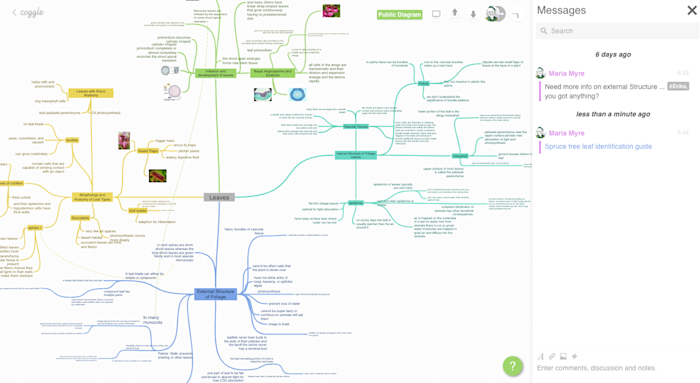
The moment you log in to Coggle, you’ll see the central node of a new mind map, along with an enticing plus sign to get started adding new nodes and ideas. Each time you click on the plus sign to create a new child node, Coggle will automatically choose the direction and placement of the new node. But you can always drag the nodes around to rearrange into a format that fits your layout a little better.
If you prefer to use keyboard shortcuts during your mind mapping process, there’s a cheat sheet of keyboard shortcuts in the bottom right corner of the canvas. Click the green X icon to hide it and the green question mark icon to bring it back.
One of our favorite features is that Coggle lets you format your mind map items and messages with Markdown, so you can get as fancy as you need to while adding your text, images, and links to the canvas.
If you want to bounce some ideas off a friend, you can go ahead and add them to your mind map, carry on a conversation in the messages sidebar, or go into full-screen presentation mode to take a step back and do more high-level ideation.
Coggle Pricing: Free for up to three private diagrams; $5/month for unlimited private diagrams and extra mind mapping tools (like additional shapes and color control).
Best mind mapping software for mobile
Mindly (macOS, iOS, Android)

Mind mapping on a mobile device comes with a full suite of challenges, thanks to small screen sizes, the inconvenience of scrolling and zooming, and the readability issues that accompany all that. But Mindly’s outside-the-box thinking makes mind mapping on a phone possible—and, honestly, pretty fun.
Like most mind maps, you’ll start with your central node, add text and icons, and change the color if you want. Then, it’s time to start adding any associative ideas in the next outer layer. To do this, tap on any circle that you want to start adding your ideas to: Mindly will automatically open a new layer and zoom in to let you focus on the matter at hand. As you go deeper into sub-ideas (and sub-sub-ideas!), you’ll always be able to find your way back to the original center node by tapping on the circle in the top-left corner of the screen.
Of course, you can sync your mobile mind maps with the desktop version of Mindly, so you can switch from on-the-go ideation to formal mind mapping sessions at your desk.
Mindly Pricing: Free mobile version includes 3 mind maps each with up to 100 elements; $6.99 on iOS and $5.49 on Android for additional features including unlimited elements, passcode, and search; $29.99 on macOS.
Best free mind mapping software
diagrams.net (Web, macOS, Linux, Windows, Chrome OS)
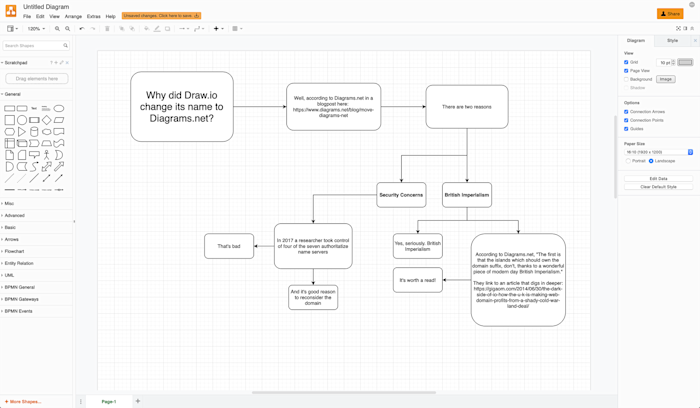
diagrams.net, formerly draw.io, lets you draw and create almost anything you want—including mind maps. Its drag-and-drop canvas allows you to add shapes, links, text, and images, as well as change colors, connect your ideas with lines, and so on.
Because it’s not strictly a mind mapping tool, you’ll have to work a bit harder to manually add connecting lines between ideas and rearrange them so that everything fits nicely on the canvas. But some people will prefer the lack of templates because it gives you a little more freedom to find new, unexpected correlations between ideas.
As a web-based app, you can access it directly from your browser, without even having to log in to an account. Or, go ahead and download the desktop version if you prefer to work outside of the browser.
diagrams.net Pricing: Free.
Best mind mapping software for creating public mind maps
MindMup (Web)
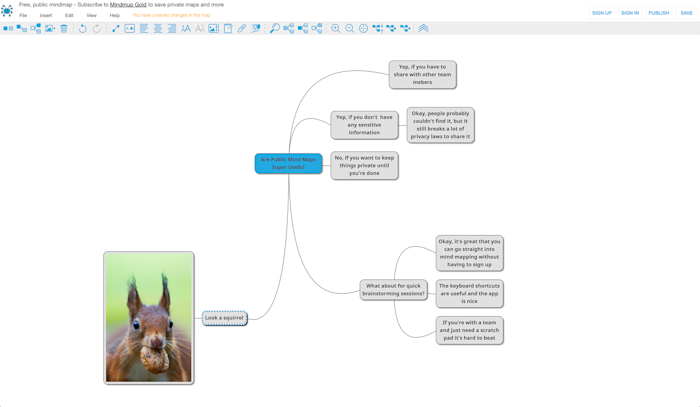
The MindMup toolbar is easy to use, providing quick links for all the basic needs of mind mapping, from changing the color of each node to adding detailed text and file attachment. But it’s the ability to publish and share your mind maps that sets MindMup apart.
While many mind mapping tools require at least an email address before you’re able to use their system, MindMup allows anyone to create and post public mind maps without signing up. Free mind maps are automatically deleted after six months, but if you’re using it for a quick brainstorming session, that does the trick. If you want to sign up or save private maps, you have to pay $2.99/month for MindMup Personal Gold.
MindMup Pricing: Free for public maps up to 100 KB; from $2.99/month for MindMup Personal Gold that includes larger, private maps and collaboration.
Best mind mapping software for collaborating with a team
MindMeister (Web, iOS, Android)
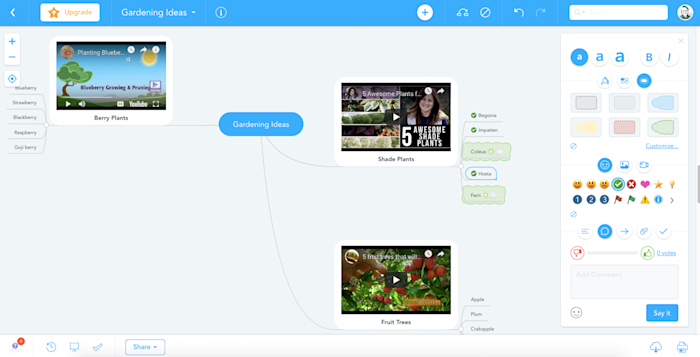
MindMeister is a robust tool that includes everything from quick keyboard shortcuts to the ability to embed live videos inside your nodes. And its collaboration features are extensive: you can add team members to your mind map, upvote and downvote ideas, and leave comments.
MindMeister is owned by the same people that make MeisterTask, a web-based, kanban-style project management app. The two tools are integrated so you can turn your brainstorm session into an actionable project, assigning individual items on a mind map to members of your team, tracking task progress, and syncing it all with your other project boards inside MeisterTask—which even integrates with Zapier.
For an in-depth look at what a sample MindMeister/MeisterTask project might look like, take time to read through our article about how to jumpstart new projects with mind maps.
MindMeister Pricing: Free for the Basic plan that includes up to three mind maps and real-time collaboration. From $4.99/month for the Personal plan that includes unlimited mind maps, file attachments, and PDF exports.
Best mind mapping software for fluid, non-traditional mind mapping
Scapple (macOS, Windows)

Most mind maps require you to begin with a central node, branching outwards from that single point as your mind comes up with new ideas and associations. But if you’re using Scapple, you have more flexibility in terms of where your visual mind map leads.
For example, you’re not limited to starting your mind map with a central theme. Instead, you might start with a tiny idea, then work “backward” to find the main idea. And Scapple lets it all happen organically, since individual nodes will only connect when you tell them to by dragging and dropping one on top of the other. In this way, complex relationships can be sketched out quickly, without losing the flow of rapid ideation.
When compared with some of the other mind mapping apps on this list, Scapple’s interface is relatively simple. You can’t even style a note unless you activate the inspector by going to View > Show Inspector. But that simplicity also gives you the ultimate flexibility in terms of what goes where and how things should look.
One great touch is that the 30-day free trial is for 30 days of use, not 30 consecutive days. Use Scapple a couple of times a month and it’s free for almost a year.
Scapple Pricing: 30-day free trial; $18 for the Mac or Windows app.
Best mind mapping software for linear mind mapping
SmartDraw (Web)
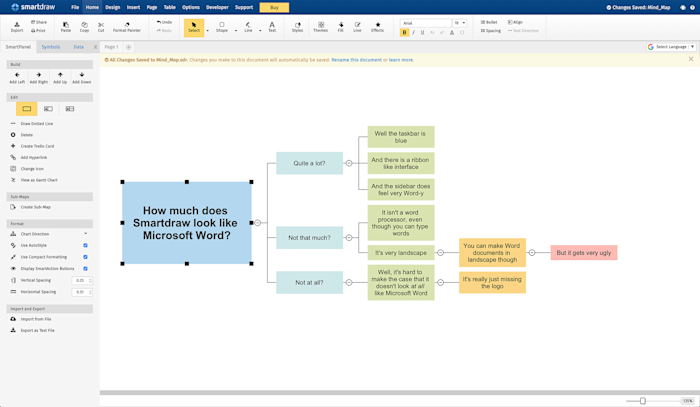
In a world of curves and circles, SmartDraw stands out as a linear mind mapping solution. Sub-ideas begin either on the left or right of the central node, and each subsequent sub-idea continues in that same direction. The benefit of this layout is that the entire mind map resizes automatically to fit your growing ideas, and you never have to worry about one idea infringing on another’s space. And, while the finished result might look more like an organized flowchart, it still follows the free ideation format of the mind map.
The benefit of a linear layout like this isn’t limited to personality types who prefer straight lines and organization. Rather, it allows your brain the freedom to create a mind map with the usual process, then shift gears to examine the logic of how each idea connects with the others.
SmartDraw Pricing: $9.95/user/month billed annually; team accounts with more than 5 users are discounted at $5.95/user/month.
Best mind mapping software for in-person mind mapping sessions
Stormboard (Web)
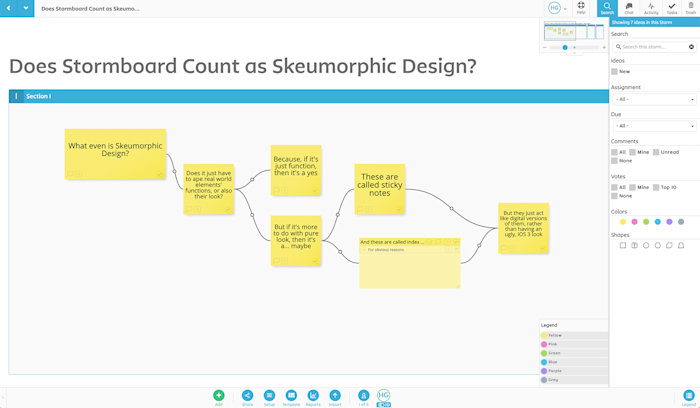
Stormboard puts a twist on traditional mind mapping by using sticky notes and index cards, rather than nodes and branches, to record your ideas. You’ll group your notes on different parts of the screen to represent connections during the initial mind map creation, then add the visual correlations with lines afterward.
There’s even a “rapid-fire” mode that will pop up a new sticky note the minute you post the one prior, so you can literally type out your ideas one after another with no extra effort—and save the organization for later.
Stormboard also makes it easy to get your entire team involved in the process, since collaborators can record comments, create tasks, and add their votes to each idea. Plus, you can automate the process with Stormboard’s Zapier integrations, creating ideas and storms automatically whenever trigger events happen in the other apps you use most. For example, new Trello cards or GitHub issues can automatically pop up on a dedicated board.
Stormboard Pricing: Free for the Personal Plan that includes a maximum of 5 stormboards; from $5/month for the Startup Plan that offers access to additional features like advanced recording, live editing on Microsoft Office Online, template section labels, and additional export options.
If you’re gravitating toward creating your mind maps with sticky notes, you might also consider Padlet or MURAL.
Best mind mapping software for turning your mind map into an organized flowchart
Lucidchart (Web, iOS, Android)
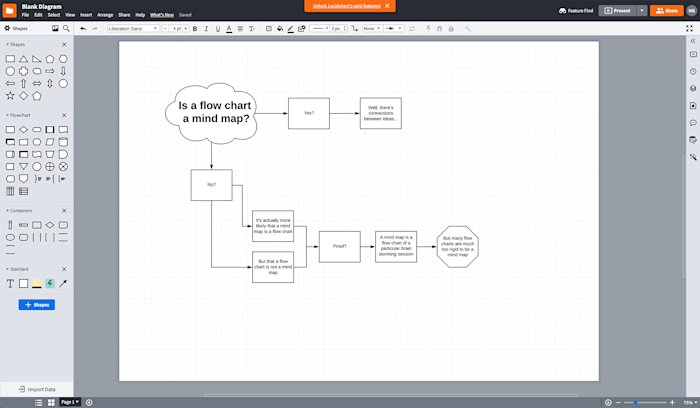
Lucidchart is primarily known as a flowchart app. It includes all the elements you need to create a mind map, but also allows you to rework and refine your ideas into an organized, detailed flowchart. The mind map creation itself is simple: Drag and drop shapes onto the canvas to represent each idea and sub-idea in your mind map. Then, create visual connections by clicking and dragging lines between related ideas.
Once you’ve created your basic mind map, you can turn to Lucidchart’s other features to flesh out your ideas and fine-tune the connections between them. For example, you might decide to bring in some data and automate the next steps of your project, whether that means generating a UML sequence diagram, importing CSV files, or linking objects in your diagram to data that exists in Google Sheets.
In short: When you need to turn your mind map into something more technically concrete, Lucidchart gives you the tools you need to make it happen.
Lucidchart Pricing: Free for up to three mind map documents; from $7.95/month for the Individual plan that includes unlimited documents and more professional templates.
Best mind mapping software for a modern mind mapping approach
Ayoa (Web, iOS, Android, macOS, Windows)
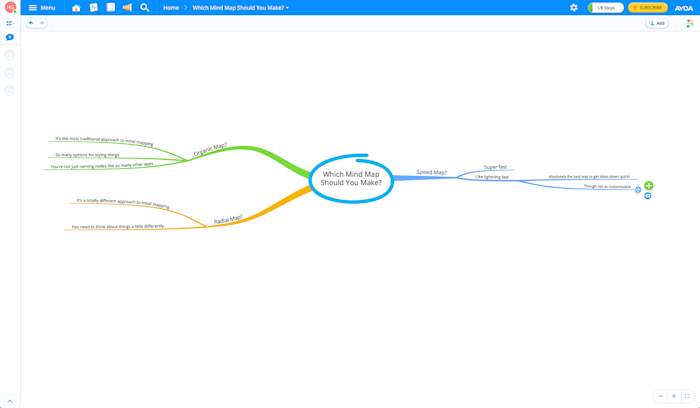
Ayoa is the follow-up to one of our previous mind mapping picks, iMindMap. It was created by Chris Griffiths, a mind mapping expert and author who has collaborated with Tony Buzan, the man responsible for popularizing mind mapping in the 1970s. Put simply, it’s got a serious mind mapping pedigree—and it shows.
Open Ayoa, and you have a choice of making an Organic Map, a Speed Map, or a Radial Map. The Organic Map is the most traditional, and mimics the kind of thing you’d draw with a pen and paper. You aren’t confined to just putting words in boxes. Instead, you’re encouraged to label the swooshing, Sharpie-like branches that connect different ideas. It’s a much more natural process than a lot of the other apps.
A Speed Map is similar, but with a stripped-down setup designed for rapid brainstorming. You’re almost forced to use keyboard shortcuts, like Tab for a new child branch and Enter for a new sibling branch, as the buttons to do the same are hidden away unless you deliberately click on a node. It’s great when you want to ideate quickly.
A Radial Map is a totally modern approach to mind mapping. Instead of nodes and lines, every idea becomes part of a series of concentric circles. A peripheral segment of your central idea becomes the center of its own circle of ideas as you move outwards. It’s mind mapping that’s moving beyond the limits of what can even be imagined with paper.
And Ayoa isn’t just limited to basic (and not-so-basic) mind mapping. The chat, real-time collaboration, and task management features make it ideal if you’re part of a small team looking to realize your ideas.
Ayoa Pricing: Free Basic plan with up to 5 boards and real-time collaboration; $12/month Pro plan with unlimited boards, file attachments, and the ability to export your mind maps.
Best mind mapping software for Apple users
MindNode (iOS, macOS)
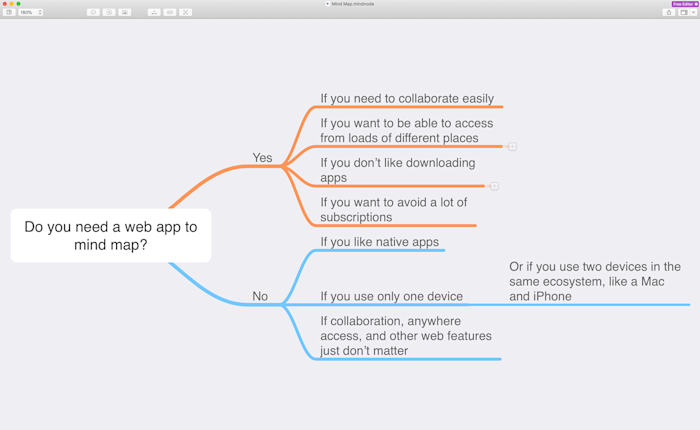
Most mind mapping apps are web apps and, if there’s a native app available, it’s really just a shell for the web app. It’s fine if you want the collaboration, sharing, and other features you get with an online service, but what if you just want a simple way to brainstorm by yourself?
MindNode, a native Mac, iPhone, and iPad app, is perfect for Apple users. Start a new map on one device and it instantly syncs to your other devices using iCloud. The app is just as easy to use (and as powerful) whether you prefer to tap the plus icon to add a new node on your iPhone or click it on your Mac. And since it’s a fully native app, no internet connection? No problem.
MindNode also has a load of other features that will keep you happy if you’re deep in Apple’s ecosystem, like a Watch app, Apple Pencil support, and integration with popular to-do apps Apple Reminders, Things, and OmniFocus. Select any node, and click Add Task to turn it into a to-do item. Or click the share menu and Export to Things (or OmniFocus), and your mind map will get converted into a project in your chosen app with all your to-dos ready to be checked off. It’s a great way to turn a brainstorming session into something actionable.
MindNode Pricing: Free limited Mac and iOS app; $2.49/month for MindNode Plus with image support, tasks, themes, and styling options.
Which mind mapping app should I use?
Mind mapping is a personal experience. How your brain works will determine which app is best for you. Are you usually at your desk while brainstorming, or do your best ideas come when you’re on the road? Do you think linearly, or do your ideas come out in a random order? Do you tend to brainstorm with your team or on your own? Think through all these questions, and take advantage of the free trial on all of these apps before selecting your winner.
This piece was originally published in February 2019. It was most recently updated with contributions from Harry Guinness in February 2020.
Need Any Technology Assistance? Call Pursho @ 0731-6725516

